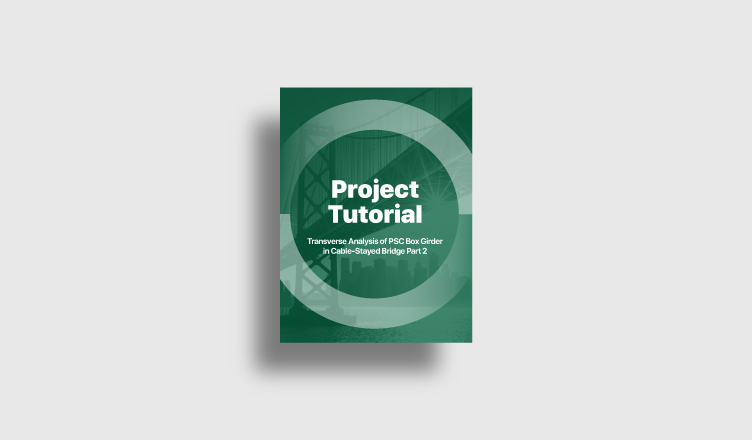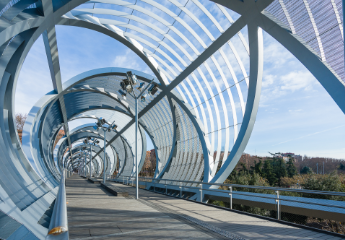Please fill out the Download Section (Click here) below the Comment Section to download the Full Webinar PDF File
In this webinar, we will follow a step-by-step modeling example for the transverse analysis using various functions in midas Civil. Additionally, we will provide information about the usage and meaning of each function.
This case study highlights:
1. Creating Elements and Edit Functions
2. Static Load Cases
3. Boundary Conditions
Below you will see a Prestressed Concrete Box Girder, a type of superstructure used for transverse analysis. This girder was modeled with plate elements, and in order to consider all conditions around the structure, various features in midas Civil were used. The conditions are shown in the figure below.
/Contents/Project%20Tutorials/Transverse%20Analysis%20of%20PSC%20Box%20Girder%20img/1_Fig.%20All%20conditions%20around%20the%20girder.jpg?width=700&name=1_Fig.%20All%20conditions%20around%20the%20girder.jpg)
/Contents/Project%20Tutorials/Transverse%20Analysis%20of%20PSC%20Box%20Girder%20img/2_Fig.%20Girder%20model%20of%20the%20webinar1.jpg?width=731&name=2_Fig.%20Girder%20model%20of%20the%20webinar1.jpg)
1. Creating Elements and Edit Functions
Midas Civil is based on nodes and elements for modeling. Nodes and elements can be created directly, and also imported from other software, ex. CAD SW. Furthermore, midas Civil provides various features to edit a model after creating nodes and elements. The modeling process for the model of this webinar is shown below:
Step 1. Import drawing file to midas Civil
Step 2. Check and modify the local axis of the element imported
Step 3. Use edit functions to model a girder
Step 4. Check the model and complete modeling work
/Contents/Project%20Tutorials/Transverse%20Analysis%20of%20PSC%20Box%20Girder%20img/3_Fig.%20Import%20function1.jpg?width=732&name=3_Fig.%20Import%20function1.jpg)
/Contents/Project%20Tutorials/Transverse%20Analysis%20of%20PSC%20Box%20Girder%20img/4_Fig.%20Edit%20functions.jpg?width=732&name=4_Fig.%20Edit%20functions.jpg)
2. Static Load Cases
This webinar shows the usage of various static loads using several functions in midas Civil. All static loads can be managed in individuals or groups using Static Load Cases Function. An example video is shown below.
1. Self Weight Function
2. Plan Loads Function
3. Nodal Loads Function
4. Pressure Loads Function
5. Element Temperature Function
6. Tendon Prestress Loads Function
/Contents/Project%20Tutorials/Transverse%20Analysis%20of%20PSC%20Box%20Girder%20img/5_Fig.%20Plane%20Loads%20for%20barriers1.jpg?width=733&name=5_Fig.%20Plane%20Loads%20for%20barriers1.jpg)
3. Boundary Conditions
There are various types of boundary conditions in midas Civil. In this model, simple supports and links were used. Define Supports Function in midas Civil restrains the degrees of freedom of selected nodes. Furthermore, link functions such as Elastic Link, Rigid Link, and General Link connect two nodes with their stiffness. An example video is shown below.
/Contents/Project%20Tutorials/Transverse%20Analysis%20of%20PSC%20Box%20Girder%20img/6_Fig.%20Boundary%20Condition%20-%20Simple%20Support.jpg?width=734&name=6_Fig.%20Boundary%20Condition%20-%20Simple%20Support.jpg)
/Contents/Project%20Tutorials/Transverse%20Analysis%20of%20PSC%20Box%20Girder%20img/7_Fig.%20Boundary%20Condition%20-%20Link%20Types.jpg?width=733&name=7_Fig.%20Boundary%20Condition%20-%20Link%20Types.jpg)
Watch the full webinar video
In addition to the webinar content, it is important to note the significance of transverse analysis in bridge engineering. Transverse analysis is an important aspect of structural analysis that focuses on the lateral forces acting on a bridge. The failure to conduct proper transverse analysis can lead to catastrophic consequences, such as the 2007 collapse of the Cable-Stayed Bridge in São Paulo, Brazil, which resulted in the death of several people.
One of the key applications of transverse analysis is in the design and construction of PSC Box girder bridges, which are commonly used in modern bridge engineering. The transverse analysis of these types of bridges helps to ensure their stability and structural integrity. This involves conducting both static and dynamic analysis of the bridge structure.
Static analysis is an important part of transverse analysis and involves the determination of the internal forces and stresses that occur within the bridge structure under static loading conditions. This includes the application of various types of loads such as self-weight, live loads, and wind loads. The final stage analysis of a bridge involves the consideration of all loads and forces acting on the bridge structure to ensure that it is safe and meets the required design specifications.
Similarly, the static analysis of cable-stayed bridges is an important aspect of bridge engineering. Cable-stayed bridges are known for their aesthetic appeal and are commonly used for long-span bridges. However, the design and construction of these types of bridges require careful consideration of their complex cable system and the lateral forces acting on the bridge structure.
In summary, the webinar on the transverse analysis of PSC Box girder bridges using midas Civil is a valuable resource for bridge engineers and designers. By providing detailed instructions and examples of various functions in midas Civil, the webinar helps to ensure the structural integrity and safety of modern bridges, including cable-stayed bridges, and prevent catastrophic failures like the one that occurred in São Paulo, Brazil.
 Get Started midas Civil
Get Started midas Civil
 Featured blog of this week
Featured blog of this week









